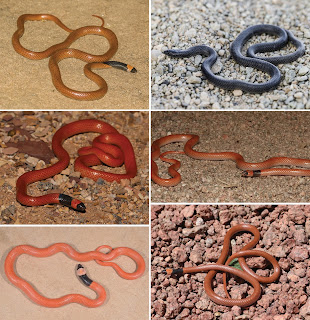 |
| Rhynchocalamus hejazicus Licata, Pola, Šmíd, Ibrahim, Liz, Santos, Patkó, Abdulkareem, Gonçalves, AlShammari, Busais, Egan, Ramalho, Smithson & Brito, 2024 |
Abstract
Discovery rates of new species are uneven across taxonomic groups and regions, with distinctive and widely distributed species being more readily described than species with secretive habits. The genus Rhynchocalamus includes five species of secretive snakes distributed from Egypt eastwards to Iran, including the Arabian Peninsula. A wide biogeographic gap exists within the genus, which separates R. dayanae found in south Israel from R. arabicus, which occurs in the coastal areas of south Yemen and Oman. We describe Rhynchocalamus hejazicus sp. nov., a small, secretive snake, with a distinctive colouration and a melanistic morph. The new species occurs in the northwestern Hejaz region of the Kingdom of Saudi Arabia (KSA) and fills a large part of the existing distribution gap of the genus in the Arabian Peninsula. Molecular analyses of mitochondrial (12S, 16S, cytb) and nuclear genes (cmos, MC1R, NT3, RAG1) indicate that R. hejazicus sp. nov. is closely related to R. dayanae and R. arabicus, but uncertainty on the deep relationship within the genus remains. The new species has a large distribution range which potentially includes other regions in Jordan and KSA, and is associated with mountainous areas with cold wet seasons. Furthermore, it inhabits sandy and stony soils with varying vegetation cover and can be found in anthropogenically disturbed habitats, suggesting that the species should not be categorised as threatened according to IUCN criteria. The discovery of such a distinctive species highlights the existing gap in the description of rare and secretive species, and the need to enhance sampling efforts and monitoring strategies to fully capture species diversity in unexplored areas.
Key Words: Biogeography, Colubrinae, Middle East, secretive species, Serpentes, species distribution model
Rhynchocalamus hejazicus sp. nov.
Diagnosis: The new species of Rhynchocalamus from the Hejaz Mountain range in western Saudi Arabia is characterised by the following morphological characters: (1) SVL 209.2–339.5 mm in adults; (2) tail length 38.3–64.2 mm in adults; (3) loreal scale present; (4) large 3rd and 4th upper labial scales in contact with the eye; (5) one preocular scale; (6) 1–2 postocular scales; (7) one temporal scale; (8) 0–2 post–temporal scales; (9) six upper labial scales; (10) eight lower labial scales; (11) usually four lower labial scales in contact with the anterior inframaxillars; (12) usually one gular scale in contact with ...
Etymology: The species name is a latinized noun in masculine gender derived from the word "Hejaz–" = Hejaz Mountains, a mountain range located in the Hejaz region (an important region located in western Saudi Arabia, where the two holy cities of Islam, Mecca, and Medina are located) where most individuals were observed, and the Latin suffix "–icus" = “belonging to”. We suggest the common name “Hejaz black–collared snake” in English and أبو حناء [Abu Henna] in Arabic for the new species.
Fulvio Licata, Lukáš Pola, Jiří Šmíd, Adel A. Ibrahim, André Vicente Liz, Bárbara Santos, László Patkó, Ayman Abdulkareem, Duarte V. Gonçalves, Ahmed Mohajja AlShammari, Salem Busais, Damien M. Egan, Ricardo M. O. Ramalho, Josh Smithson and José Carlos Brito. 2024. The Missing Piece of the Puzzle: A New and widespread Species of the Genus Rhynchocalamus Günther, 1864 (Squamata, Colubridae) from the Arabian Peninsula. Zoosystematics and Evolution. 100(2): 691-704. DOI: 10.3897/zse.100.123441



